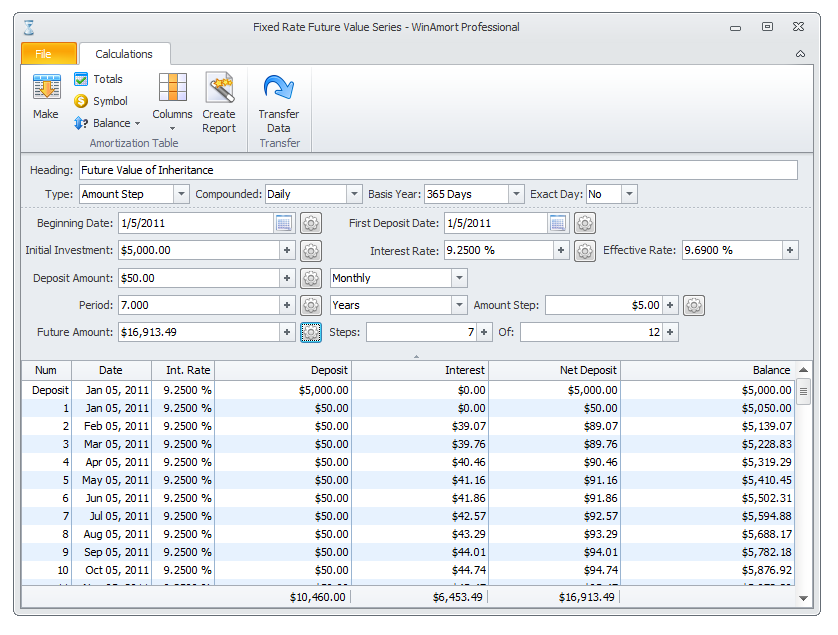
Future Value Example 2ab |

|

|

|

|
||
|
Future Value Example 2ab |

|

|

|

|

|
Future Value Example 2ab
|
|
||
Future Value - EXAMPLE 2a |
Suppose that you inherit 10 acres of land and $5000.00. The money is placed in a savings account paying daily interest and will be yours in 7 years (Strange relative). The land is currently rented out under the following contract. The neighboring farmer uses it for a fee. He can plough the land at a cost of $600.00 per year ($50.00 monthly). And that the rent will increase by $5.00 a month annually. He will deposit the money in the same daily interest account held for you. You will be allowed to have access to the land and the account in 7 years. How much money will have accumulated at the end of this time? Starting January 5,2011. |
![]() Solve The Future Value or accumulated amount at the end of 7 years.
Solve The Future Value or accumulated amount at the end of 7 years.
 Use all the known information and your knowledge of the Future Value form and fill
Use all the known information and your knowledge of the Future Value form and fill
in the fields. Then compute the answer.
Press
|
The Future value amount after 7 years will be: $16,913.49 |
Check your form with the illustrated one below.

Fact: The difference between Percent step and Dollar step is that if you stepped by 10%, then after the first year the rent would increase by
$5.00 (10% of $50.00), the same as the dollar step. However, the next year the rent would increase by another 10%, which would be (10% of
$55.00). So the increase would be $5.50 rather than another $5.00. The following year it would be (10% of $61.50) and so on. You therefore
use dollar step when you want to keep the increase at a steady amount.
To see the difference, change the Deposit type to Percent Step and recompute the Future Value amount again. You will notice that the amount
is much larger, due to the incremental effect of the Percent step deposit type.
At this point, If you press the down arrow button beside the TYPE field, you will see a third category under Deposit type.
This category is called “Skipped”. This is exactly what it means. You can compute Future Values taking into account skipped payments.
Lets take a look at the Skipped Payment
Skipped Payments
Let’s continue on the land example 2 from the previous page.
Future Value - EXAMPLE 2b |
Let’s say that after the 7 year term, you do not want to sell the land. The farmer is still willing to rent the land from you. However, the farming business is not what it used to be. The farmer cannot afford to pay you the previous rate. You do not really need the income so you make a deal. The farmer will pay you $80.00 a month (Recall the $5.00 increase every year since you inherited the farm). However he will only pay you for 8 months of the year, since the land is not workable in the winter. You agree and sign a contract for another 3.5 years (42 months). The interest rate is 7.75% per annum compounded monthly. The contract starts on March 1, 2018. (The last example ended Dec 5, 2017) |
![]() Solve The Future Value or accumulated amount at the end of 7 years.
Solve The Future Value or accumulated amount at the end of 7 years.
 Select the “Skipped” choice in the Deposit Type field.
Select the “Skipped” choice in the Deposit Type field.
Once again fill in the form using the information provided in the example.
Your filled out form should look like the one illustrated below.
Note: The first deposit is in March since the farmer is going to pay for 8 months
which covers up to October and then stop payment for 4 months starting again
in March.
Press
|
The Total Amount the farmer pays is: $2,755.10 |
If you scroll down the table you will see in the deposit field there will be 8 payment of $80, followed
by 4 payments of $0.00. Then the $80 resumes...
This covers all of the features of the Future Value of an Annuity function. But,
by no means does this cover all of the capabilities of the function. In the next
chapter we look at Present Value of an Annuity. We will be returning to this
form in order to make some of the calculations. As far as Future Value is concerned,
if you are not comfortable with it by now, it is best understood by trying
some examples on your own. Generate different scenarios and work out different
answers until you feel you understand the concept. The SOFTWARE can
help you to calculate any unknown in seconds and give you the ability to see
how your money can grow in time.